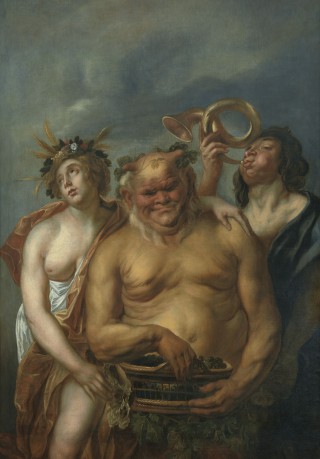Flora, Silenus and Zephyr
- Date
- 18th c.
- Object type
- painting
- Technique
- oil
- Material
- canvas
- Dimensions
- 179,5 x 122,0 cm
- Acquisition date
- 1783
- Location
- The Palace on the Isle - Bacchus Room, ground floor
- Marks and inscriptions
- red number 93 of the Stanisław August collection, bottom left
- Place of Origin
- Flanders (Europe; region)
- Owner
- The Royal Łazienki
- Museum number
- ŁKr 854
In the catalogues of the Stanisław August collection and inventories of the Łazienki Palace, the painting is listed without giving an author, as depicting Silenus with hommes or with female bacchantes. ...
This is a copy, or more precisely an altered variant of Jordaens’ composition, depicting Silenus in the company of Flora and Zephyr playing a horn. The original was once believed to be the painting owned by the Parmetier family in Knokke in Belgium ... , whereas nowadays the painting purchased for a private collection in Berlin ... in 2004 ... , once in Mount Stuart, in the Earls of Bute collection ... . An engraving on copper was made after this very painting by Schelte à Bolswert, signed Jac. Jordaens invent. et pinxit/ S.A. Bolswert sculpist ... . A sketch drawing in the Kupferstichkabinett (Staatliche Museen) in Berlin, with the title Flora, Silenus and Zephyr handwritten by Jordaens, signed and dated 1639 ... .
It used to be assumed that Jordaens’ painting was a portrait historié: the artist gave his own features to the bearded and moustached Silenus, while the features of his elder daughter, Elisabeth (b. 1617), were used to portray Flora. ...
... The painting repeats the setting and gestures of the figures of the Flora, Silenus and Zephyr composition while totally changing the physiognomy of the first two deities and the turn of the goddess’ head (which is shown en face in Jordaens’ original). In this case one cannot talk about portrait-like images. The grotesque physiognomy of the laughing Silenus is reminiscent of a decorative mask—a gargoyle; an analogy can be found in Jordaens’ drawing of a head of the Laughing Faun in the Kupferstichkabinett in Dresden ... . Flora’s head, which bears no individual features, is rendered in a typical Italianate convention and brings to mind paintings by followers of Rubens ... . [See D. Juszczak, H. Małachowicz, The Stanisław August Collection of Paintings at the Royal Łazienki. Catalogue, Royal Łazienki Museum, Warsaw 2016, no. 53, pp. 209–211.]




